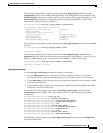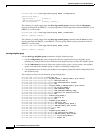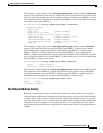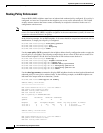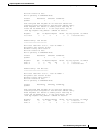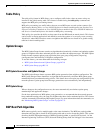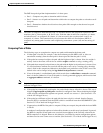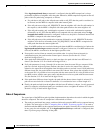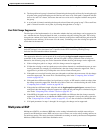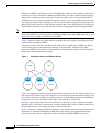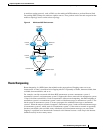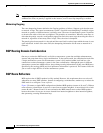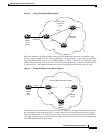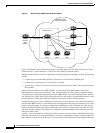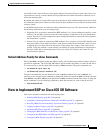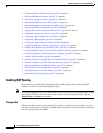
Implementing BGP on Cisco IOS XR Software
Information About Implementing BGP on Cisco IOS XR Software
RC-21
Cisco IOS XR Routing Configuration Guide
2. The best path in each group is determined. Determining the best path is achieved by iterating through
all paths in the group and keeping track of the best one seen so far. Each path is compared with the
best-so-far, and if it is better, it becomes the new best-so-far and is compared with the next path in
the group.
3. A set of paths is formed containing the best path selected from each group in step 2. The overall best
path is selected from this set of paths, by iterating through them as in step 2.
Best Path Change Suppression
The third part of the implementation is to determine whether the best path change can be suppressed or
not—whether the new best path should be used, or continue using the existing best path. The existing
best path can continue to be used if the new one is identical to the point at which the best path selection
algorithm becomes arbitrary (if the router-id is the same). Continuing to use the existing best path can
avoid churn in the network.
Note This suppression behavior does not comply with the IETF Networking Working Group
draft-ietf-idr-bgp4-24.txt document, but is specified in the IETF Networking Working Group
draft-ietf-idr-avoid-transition-00.txt document.
The suppression behavior can be turned off by configuring the bgp bestpath compare-routerid
command. If this command is configured, the new best path is always preferred to the existing one.
Otherwise, the following steps are used to determine whether the best path change can be suppressed:
1. If the existing best path is no longer valid, the change cannot be suppressed.
2. If either the existing or new best paths were received from internal (or confederation) peers or were
locally generated (for example, by redistribution), then the change cannot be suppressed. That is,
suppression is possible only if both paths were received from external peers.
3. If the paths were received from the same peer (the paths would have the same router-id), the change
cannot be suppressed. The router ID is calculated using rules in the “Comparing Pairs of Paths”
section on page RC-19.
4. If the paths have different weights, local preferences, origins, or IGP metrics to their next hops, then
the change cannot be suppressed. Note that all of these values are calculated using the rules in the
“Comparing Pairs of Paths” section on page RC-19.
5. If the paths have different-length AS paths and the bgp bestpath as-path ignore command is not
configured, then the change cannot be suppressed. Again, the AS path length is calculated using the
rules in the “Comparing Pairs of Paths” section on page RC-19.
6. If the MED of the paths can be compared and the MEDs are different, then the change cannot be
suppressed. The decision as to whether the MEDs can be compared is exactly the same as the rules
in the “Comparing Pairs of Paths” section on page RC-19, as is the calculation of the MED value.
7. If all path parameters in steps 1 through 6 do not apply, the change can be suppressed.
Multiprotocol BGP
Multiprotocol BGP is an enhanced BGP that carries routing information for multiple network layer
protocols and IP multicast routes. BGP carries two sets of routes, one set for unicast routing and one set
for multicast routing. The routes associated with multicast routing are used by the Protocol Independent
Multicast (PIM) feature to build data distribution trees.



